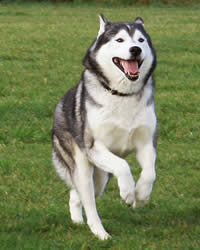Siberian Husky Breed Information
 |
| ||||||||||||||||||||||||||||||||||||||||||||||||||||||||||||||||||||||||||||||||
Just The Facts
| Do you own this Dog breed?Please tell us about it in the form at the bottom of this page. Need a good Puppy Name?Visit our Husky dog names page. |
General Description
Hard working and energetic, the Siberian Husky is a proud, social animal. The Husky is friendly to all strangers making it not the best guard dog, but a safe pet to keep around children. The husky is eager to work, and as such will require a lot of exercise and daily runs. They also have a tendency to hunt, so they should be watched closely when off leash and well trained with commands such as “Come” and “Leave it.”
Siberian Huskies come in a variety of colors, including (but not limited to) black, brown, gray, copper, blue, white, and several combinations of these shades.
Origin and History
According to DNA testing, the Siberian Husky is a direct descendent of one of the oldest dog breeds sharing its origin with the Alaskan Malamute. Its roots trace back to sled dogs in several ancient Siberian tribes. Siberian Huskies were imported to Alaska in the early 1900s and instantly became popular sled dogs due to their high energy levels and mobility.
Siberian Husky Temperament
Siberian Huskies are very friendly, with a seemingly boundless energy and a willingness to work. They get along very well with strangers, dogs and children, though other small animals (such as cats and rabbits) look more like food than friends.
Siberian Huskies are not the most loyal animals, making them difficult to train and difficult to control. But their friendliness lends them towards gentleness, and their willingness to please makes them enjoyable jogging companions.
Care, Grooming, Diet & Exercise
Living Environment – The Siberian Husky can thrive in almost any household, due to their friendliness towards all members of the family. However, it is best to avoid homes with non-canine pets, and an experienced owner may be beneficial in order to perform early obedience training. They are definitely not the best apartment dogs.
Grooming – Siberian Huskies do take quite a bit of grooming. They shed heavily, and will require a considerable brushing twice a week, and daily during periods of heavy shedding. However, baths can be infrequent as Siberian Huskies rarely have any heavy odors.
Diet & Exercise – Siberian Huskies require a great deal of exercise, Their natural intelligence and predisposition to running can make them easily bored when not active, which can lead to destructive behaviors. They need a high protein, high fat diet, with careful measuring to avoid obesity problems if they are not active.
Health – Siberian Huskies are generally healthy and live long lives. Dog eye problems are not uncommon, with canine cataracts and corneal dystrophy of concern. They are also prone to canine thyroid disorders and obesity. Proper certification is beneficial for parents of this breed.
Siberian Husky Trainability
Siberian Huskies are intelligent, but dog training is not easy. They are naturally selfish and will ignore commands that appear to have no purpose. In addition, though not particularly aggressive they often see themselves as pack leader when not consistently trained with a firm hand.
Obedience training should begin at a very young age and continue well into adulthood. House training can also be difficult, so crate training should start early.
Do you own this dog breed?
Please tell us about your experience with a particular dog breed, and upload a picture if you have one!
What Other Visitors Have Said
Click below to see contributions from other visitors to this page...
Siberian Husky - Not so selfish 




Growing up, I had 3 huskies at my mother's. My mom had just recently adopted a new little puppy and, as a kid, I enjoyed the new family member.
As I …
Return from Siberian Husky Breed Information back to List of Dog Breeds page